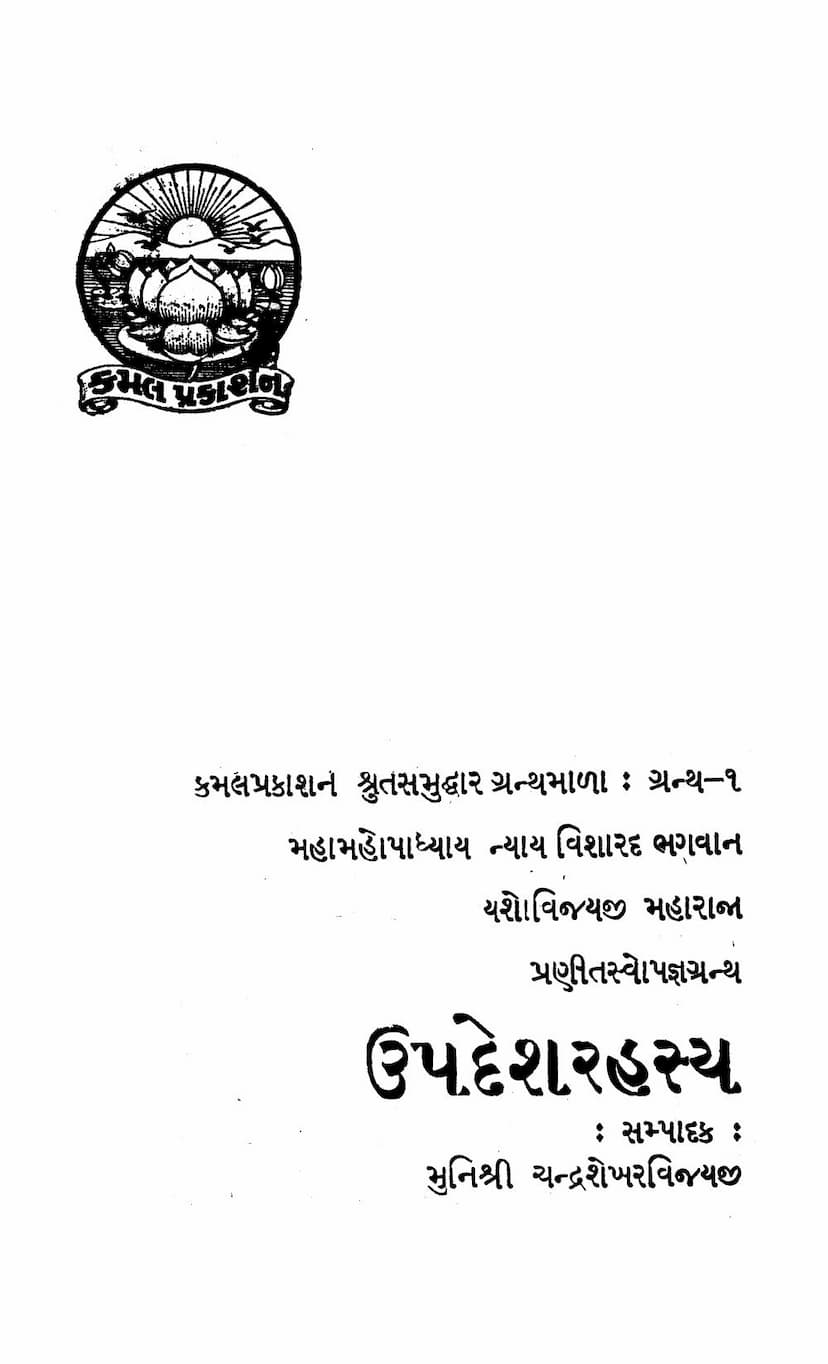Updesh Rahasya
Added to library: September 2, 2025

Summary
Here is a comprehensive summary of the Jain text "Updesh Rahasya" by Chandrashekharvijay, published by Kamal Prakashan, based on the provided catalog link and page content:
Book Title: Updesh Rahasya (उपदेशरहस्य) Author: Muni Shri Chandrashekharvijayji (मुनिश्री चन्द्राशेखर्विजयाजि) Publisher: Kamal Prakashan (कमल प्रकाशन) Series: Shrut Samuddhar Granthamala (श्रुतसमुद्धार ग्रन्थमाला), Granth-1
Overall Purpose and Context:
"Updesh Rahasya" is presented as a concise essence extracted from the monumental work "Updesh Pad" by Bhagwan Haribhadra Surishwarji Maharaj. The book aims to distill the profound spiritual insights and secrets of the "Updesh Pad" for the benefit of seekers (mumukshus) who aspire to progress on the path of spiritual practice (sadhana). The text emphasizes the critical importance of adhering to the commands of the virtuous (Vitrag Sarvagya Bhagwant) and integrating these teachings into every aspect of one's life. The compilation is intended to be a guide for those wishing to achieve self-development and for preachers to maintain scriptural purity in their discourses.
Key Themes and Teachings:
The text delves into the core principles of Jain spiritual practice, emphasizing the following:
- The Secret of Obedience (Anya): The central theme revolves around the profound significance of obeying the divine commands. This obedience is not merely external but should permeate every thought, word, and deed, leading to liberation. The text suggests that true joy and liberation are found in complete surrender to divine will.
- The Nature of True Knowledge (Samyak Gyan): The importance of right knowledge is highlighted as the foundation for self-awareness and spiritual progress. Without it, one cannot truly understand the soul. Right knowledge provides clarity and guides the soul towards its ultimate development.
- The Essence of Sadhana: The book stresses that sincere spiritual practice is paramount. This involves not just external rituals but a deep internal transformation. The teachings are presented as essential for those on the path of liberation.
- The Importance of Scriptures: The text underscores the value of the Jinagamas (Jain scriptures) and the need to preserve and disseminate them. It laments the potential loss of valuable ancient texts due to neglect and emphasizes the responsibility of the current generation to pass them on to future generations.
- Distinguishing True Practice from Ritual: The book implicitly critiques superficial or ritualistic practices that lack genuine understanding or inner transformation. It emphasizes that true adherence to the teachings is marked by inner purity and the absence of pride or ego.
- The Role of the Guru: The compiler, Muni Shri Chandrashekharvijayji, expresses gratitude to his spiritual master, Acharya Shri Vijay Premsurishwarji Maharaj, and acknowledges the guidance received. The text implicitly highlights the importance of a Guru in understanding and practicing the profound teachings.
- The Call for Preservation and Dissemination: Kamal Prakashan, as the publisher, is dedicated to reviving and publishing ancient Jain literature in modern Gujarati. The "Shrut Samuddhar Granthamala" is part of this initiative, aimed at making these valuable texts accessible. The publication of "Updesh Rahasya" is a testament to this commitment, with financial support from donors like Seth Shri Gulabhchand Gafferbhai and the efficient work of Nayan Printing Press.
Structure and Content (as inferred from the pages):
The initial pages introduce the book, its editor, publisher, and acknowledgments. The editorial note (Sampaadakeey) by the compiler sets the tone, emphasizing the profoundness of the "Updesh Pad" and its secrets. The subsequent pages, particularly starting from page 11 onwards, seem to be a verse-by-verse exposition of the "Updesh Rahasya," likely drawing from the original "Updesh Pad."
The verses (e.g., starting with "Namah Ekarakalitrupam...") discuss:
- The necessity of human birth and engaging in righteous conduct as taught by the Vitragas.
- The importance of truthfulness and non-violence as foundational principles.
- The difference between worldly and spiritual conduct and the pitfalls of following mere rituals without inner understanding.
- The subtle distinctions between various practices and their impact on karmic bondage.
- The crucial role of the Guru and righteous conduct in spiritual progress.
- The nature of the soul, the path to liberation, and the obstacles encountered.
- The importance of contemplation, the correct understanding of scriptures, and the gradual unfolding of spiritual realization.
- The dangers of superficial devotion, the significance of proper adherence to rituals, and the ultimate goal of spiritual practice.
The text appears to be a philosophical and practical guide, aiming to illuminate the "hidden meaning" or "secret essence" of spiritual teachings for the diligent seeker. The detailed verses suggest a thorough explanation of complex concepts, likely rooted in classical Jain logic and philosophy.